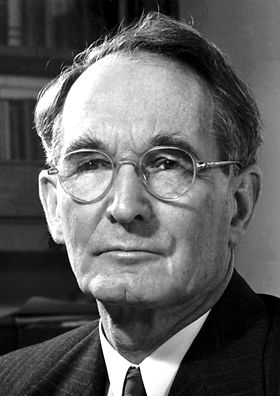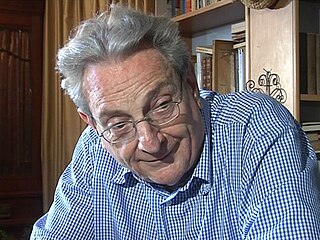Related Research Articles

Albert Einstein was a German-born theoretical physicist who is widely held to be one of the greatest and most influential scientists of all time. Best known for developing the theory of relativity, Einstein also made important contributions to quantum mechanics, and was thus a central figure in the revolutionary reshaping of the scientific understanding of nature that modern physics accomplished in the first decades of the twentieth century. His mass–energy equivalence formula E = mc2, which arises from relativity theory, has been called "the world's most famous equation". He received the 1921 Nobel Prize in Physics "for his services to theoretical physics, and especially for his discovery of the law of the photoelectric effect", a pivotal step in the development of quantum theory. His work is also known for its influence on the philosophy of science. In a 1999 poll of 130 leading physicists worldwide by the British journal Physics World, Einstein was ranked the greatest physicist of all time. His intellectual achievements and originality have made the word Einstein broadly synonymous with genius.

Peter Joseph William Debye was a Dutch-American physicist and physical chemist, and Nobel laureate in Chemistry.

James Bryant Conant was an American chemist, a transformative President of Harvard University, and the first U.S. Ambassador to West Germany. Conant obtained a Ph.D. in chemistry from Harvard in 1916.
Philipp Frank was a physicist, mathematician and philosopher of the early-to-mid 20th century. He was a logical positivist, and a member of the Vienna Circle. He was influenced by Mach and was one of the Machists criticised by Lenin in Materialism and Empirio-criticism.

Max Theodor Felix von Laue was a German physicist who received the Nobel Prize in Physics in 1914 for his discovery of the diffraction of X-rays by crystals.

Percy Williams Bridgman was an American physicist who received the 1946 Nobel Prize in Physics for his work on the physics of high pressures. He also wrote extensively on the scientific method and on other aspects of the philosophy of science. The Bridgman effect, the Bridgman–Stockbarger technique, and the high-pressure mineral bridgmanite are named after him.

Joseph Hooton Taylor Jr. is an American astrophysicist and Nobel Prize laureate in Physics for his discovery with Russell Alan Hulse of a "new type of pulsar, a discovery that has opened up new possibilities for the study of gravitation."

Vladimir Aleksandrovich Fock was a Soviet physicist, who did foundational work on quantum mechanics and quantum electrodynamics.

Peter Louis Galison is an American historian and philosopher of science. He is the Joseph Pellegrino University Professor in history of science and physics at Harvard University.
Daniel Kleppner, born 1932, is the Lester Wolfe Professor Emeritus of Physics at Massachusetts Institute of Technology (MIT) and co-founder and co-director of the MIT-Harvard Center for Ultracold Atoms. His areas of science include atomic, molecular, and optical physics, and his research interests include experimental atomic physics, laser spectroscopy, and high precision measurements.

Paul Frankl was an art historian born in Austria-Hungary. Frankl is most known for his writings on the history and principles of architecture, which he famously presented within a Gestalt-oriented framework.
Edwin Crawford Kemble was an American physicist who made contributions to the theory of quantum mechanics and molecular structure and spectroscopy. During World War II, he was a consultant to the Navy on acoustic detection of submarines and to the Army on Operation Alsos.

Reinhard Genzel is a German astrophysicist, co-director of the Max Planck Institute for Extraterrestrial Physics, a professor at LMU and an emeritus professor at the University of California, Berkeley. He was awarded the 2020 Nobel Prize in Physics "for the discovery of a supermassive compact object at the centre of our galaxy", which he shared with Andrea Ghez and Roger Penrose. In a 2021 interview given to Federal University of Pará in Brazil, Genzel recalls his journey as a physicist; the influence of his father, Ludwig Genzel; his experiences working with Charles H. Townes; and more.
Einstein and Religion: Physics and Theology (1999) is a book on the religious views of Nobel prize-winning physicist Albert Einstein by Max Jammer, published by Princeton University Press.

Yaron Ezrahi was an Israeli political theorist and philosopher, professor at The Hebrew University of Jerusalem, a senior Fellow at the Israel Democracy Institute in Jerusalem, and a public intellectual. Ezrahi was known for his work on the relations between modern science and the rise of the modern liberal democratic state and the political uses of scientific knowledge and authority. His late work focuses on the deterioration of the Enlightenment version of the partnership between science, technology and democracy, the changing parameters of postmodern imaginaries, and performances of the democratic order. His books, written in English and Hebrew, were translated into German and Chinese.

Yehuda Elkana was a historian and philosopher of science, and a former president and rector of the Central European University in Budapest, Hungary.
Katherine Sopka was a science interviewer, physics professor and historian of physics. She is known for her interviews held with leading scientists, and for work on the history of quantum physics and the physics community in the U.S. in the 1920s and 1930s.
David C. Cassidy is an American historian of science and professor emeritus at Hofstra University, Hempstead, New York. He is best known for his contributions to the history of quantum mechanics, scientific biography, history of physics in Germany and the United States and, most recently, science-history drama.
Stephen George Brush is a scholar in the field of history of science whose career spanned the late twentieth and early twenty-first century. His research resulted in hundreds of journal articles and over a dozen books.

Thematic Origins of Scientific Thought: Kepler to Einstein is a collection of essays on themes in the history of physics by Gerald Holton. It was originally published in 1973 by Harvard University Press, who issued multiple reprints of the book leading up to the publication of a revised edition in 1988. The book has been translated into several languages and has received many reviews.
References
- ↑ Holton, Gerald J. "United States Public Records Inde". See also: http://holton.physics.harvard.edu/
- ↑ https://www.neh.gov/about/awards/jefferson-lecture. See also: Gerald Holton, Advancement of Science, and its Burdens (1986), Chapter 14.
- ↑ Holton, Gerald J. "United States Public Records Inde".
- ↑ Writer, Corydon Ireland Harvard Staff (May 6, 2015). "'A completely new life was beckoning'".
- ↑ Only 7% of the targeted children in Nazi Europe survived. See: Tec, N. (1993). A Historical Perspective: Tracing the History of the Hidden-Child Experience. In Marks, J., The Hidden Children: The Secret Survivors of the Holocaust, New York: Fawcett Columbine, 273-91.
- ↑ "Welcome to the Kindertransport Association". June 30, 2021.
- ↑ On refugees from Nazi Germany, including Holton, who later entered US academia, especially in the field of historical studies, see Andreas Daum, Hartmut Lehmann, James Sheehan (eds.), The Second Generation: Émigrés from Nazi Germany as Historians. With a Biobibliographic Guide. New York: Berghahn Books, 2016, ISBN 978-1-78238-985-9, pp. 381‒3 with a brief biography of Holton, a bibliography of his publications, and a comprehensive list of honors and awards.
- ↑ See Holton, G. and Sonnert, G., “The Grand Wake for Harvard Indifference: How Harvard and Radcliffe students aided young refugees from the Nazis.” Harvard Magazine., Sept.-Oct. 2006. 50-55.
- ↑ See Holton, Nina. “Sculpture,” in Leonardo, vol. 8, 2. (Great Britain: Pergamon Press, 1975), 133-135. and also Holton, Nina. “My Clay Sculpture Series”, in Leonardo, vol. 14, 2. (Great Britain: Pergamon Press, 1981), 125-127.
- ↑ The entire collection of texts from the Project Physics Course can be accessed and downloaded for free at https://archive.org/details/projectphysicscollection. See also the dissertation by Meshoulam, David. Teaching Physics as One of the Humanities: The History of (Harvard) Project Physics, 1961–1970, (University of Wisconsin-Madison, 2014).
- ↑ See Holton, Gerald James, Science and anti-science. Cambridge, Mass.: Harvard University Press, 1993. http://nrs.harvard.edu/urn-3:FHCL:19365133. Chapters 5 and 6. Also Journal of the History of Ideas, v.61.2 (2000), 327–341).
- ↑ Book of Members, 1780–2010: Chapter H". American Academy of Arts and Sciences.
- ↑ Later issued also as a book - Science and the Modern Mind. (Boston: Beacon Press), 1958 - as were most of his issues.
- ↑ Holton, Gerald. “On the Vienna Circle in Exile: An Eyewitness Report,” in The Foundation Debate, (Kluwer Academic: 1995), 269-292.
- ↑ Holton, Gerald. “The Woman in Einstein’ s Shadow”, Chapter 2 in Victory and Vexation in Science: Einstein, Bohr, Heisenberg and Others. (Cambridge: Harvard University Press), 2005.
- ↑ One of Holton’s early indications of his findings in the Einstein collection was published in “Continuity and Originality in Einstein’s Special Relativity Theory,” in Actes du IX Congrès International d’Histoire des Sciences, September 1959, vol. 1. ( an “abbreviated version”). Also relevant are: Holton, Gerald. “Einstein, Michelson, and the “Crucial” Experiment” in Thematic Origins of Scientific Thought: Kepler to Einstein (Cambridge: Harvard University Press), 1988. Chapter 8., as well as Holton, Gerald. “Einstein’s model for constructing a scientific theory””. “Einstein and the cultural roots of modern science,” and “Einstein and the shaping of our imagination”, all in The Advancement of Science and Its Burdens. (Cambridge: Harvard University Press), 1998.
- ↑ Holton, The Advancement of Science, xvi.
- ↑ Holton, “The Roots of Complementarity,” in Thematic Origins, 1988.
- ↑ Holton, “Postscript to the Revised Edition” in Thematic Origins, 1988, 473-481.
- ↑ See his “1984 Presidential Address,” in History of Science Society Newsletter, v. 14, 2, April 1985, and “Some Lessons from History in the History of Science,” in Isis, Journal of the History of Science Society, v. 90, 52, 1999.
- ↑ "APS Member History". search.amphilsoc.org. Retrieved December 10, 2021.
